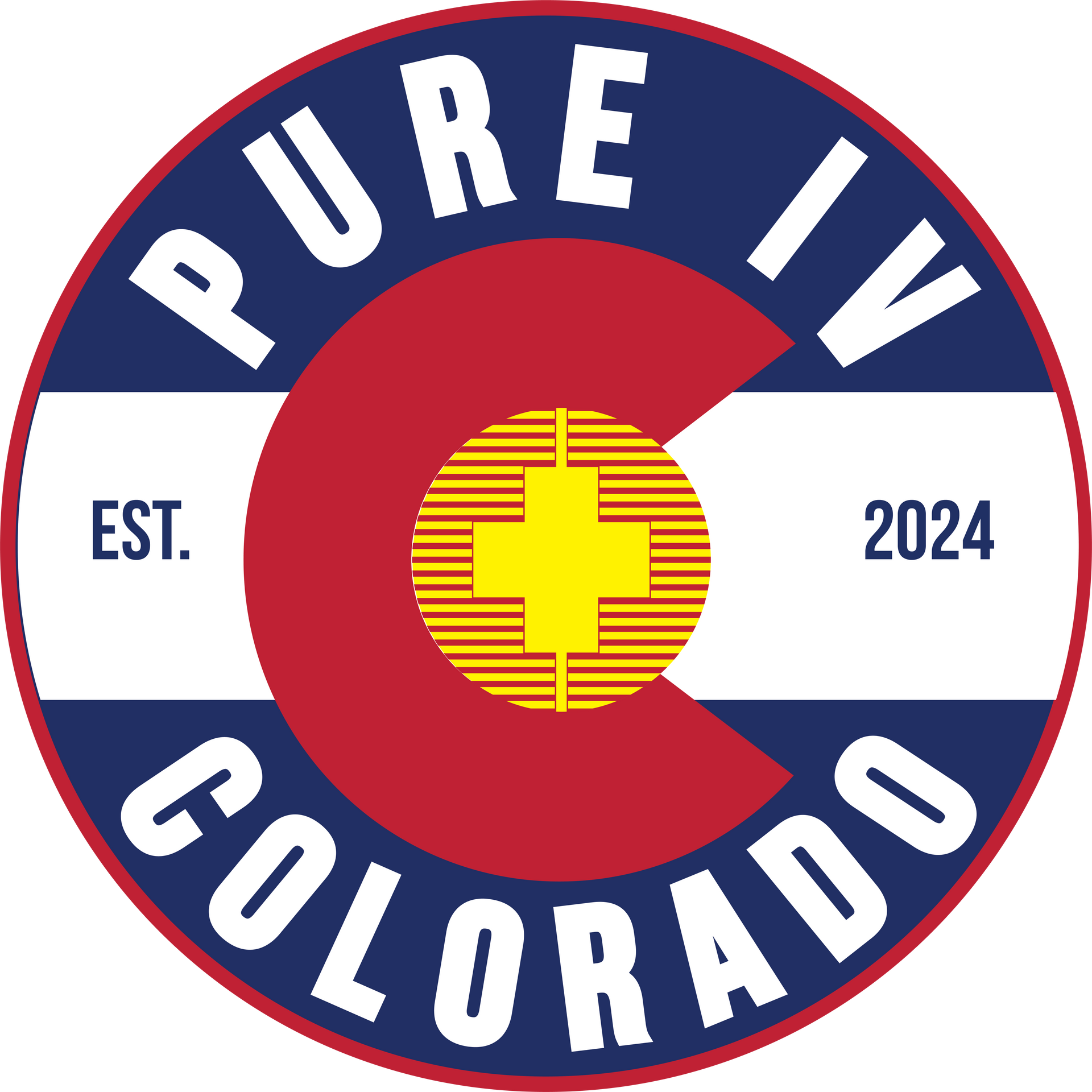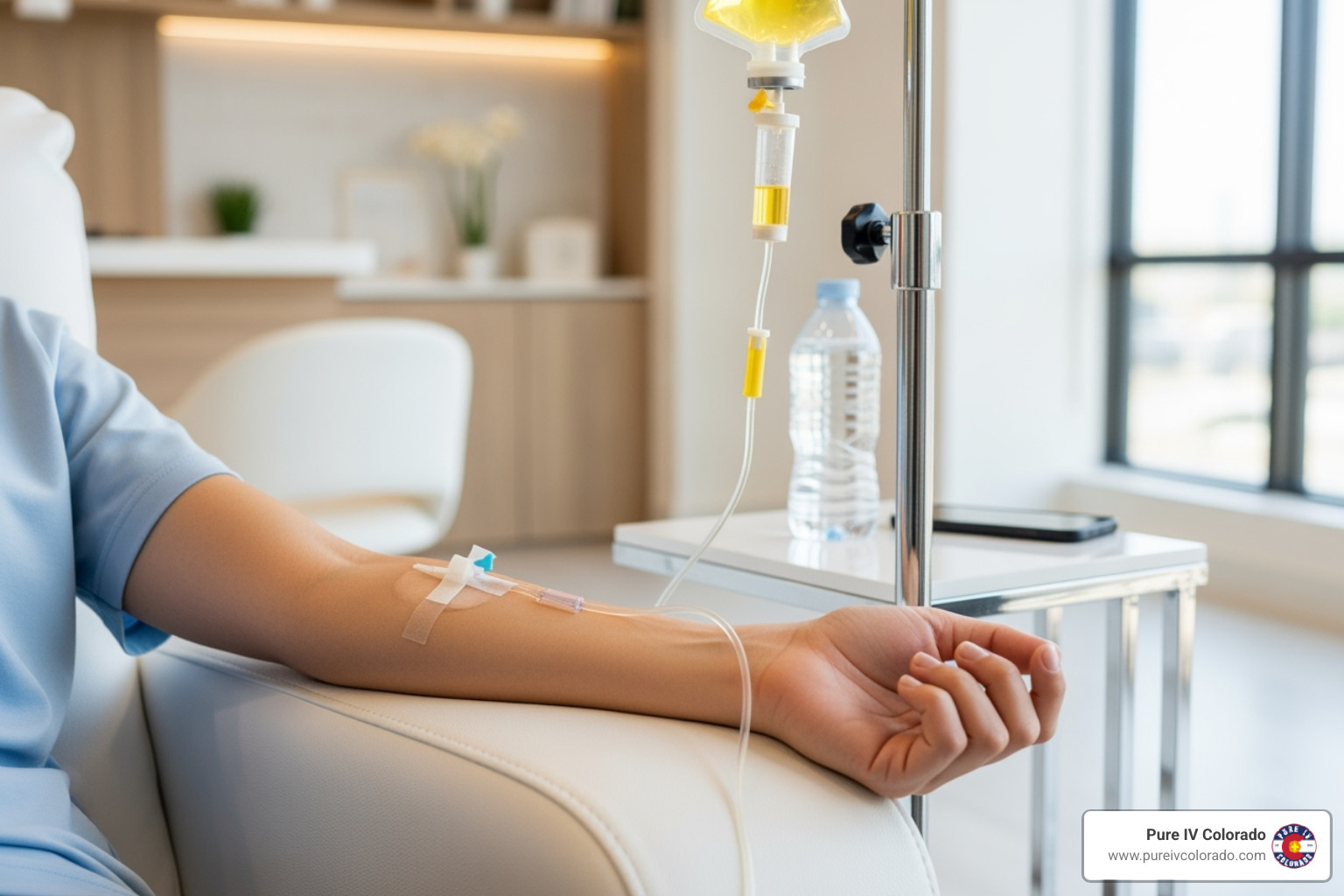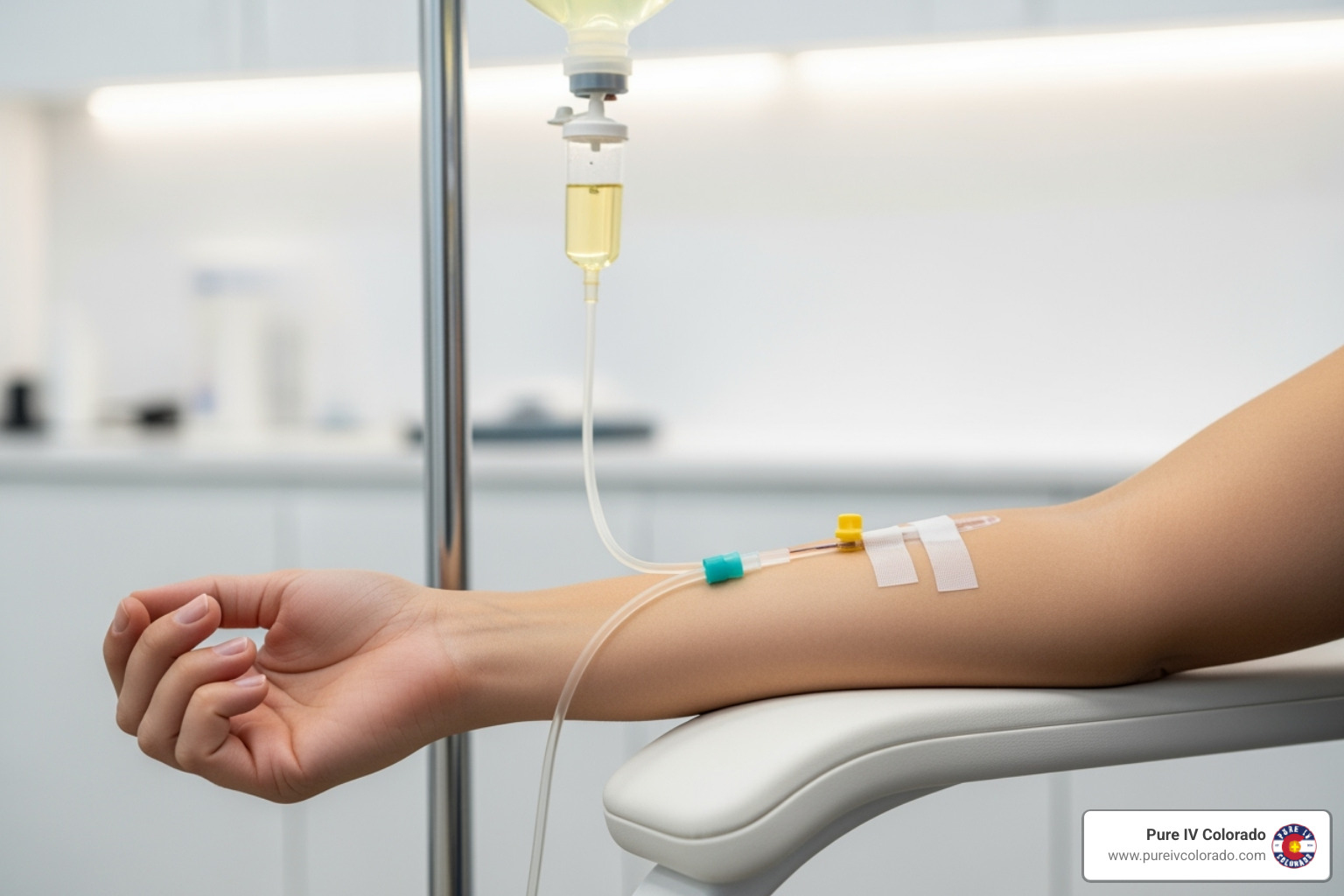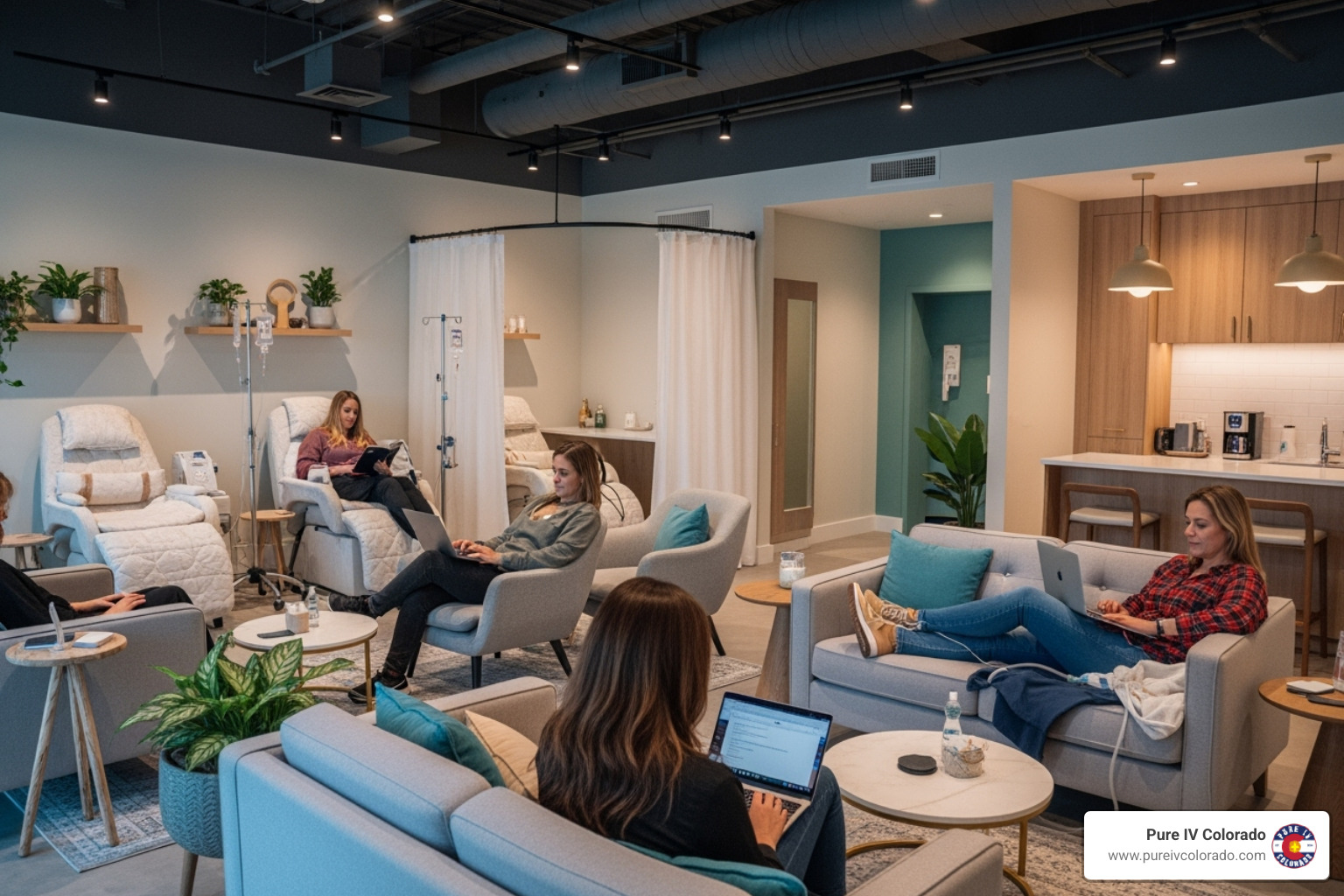IV Rehydration Solution: Rapid, Targeted Hydration for Fast Recovery
Why IV Rehydration Solutions Matter for Your Health

An iv rehydration solution delivers fluids, electrolytes, and nutrients directly into your bloodstream through a small needle in your vein. This method bypasses your digestive system entirely, allowing your body to absorb 100% of the fluids within minutes instead of hours.
Key facts about IV rehydration solutions:
- What it is: Sterile fluid containing water, salt, and other electrolytes delivered intravenously
- How it works: Direct bloodstream delivery for immediate cellular hydration
- When needed: Moderate to severe dehydration, vomiting, altitude sickness, or when oral fluids aren't enough
- Main types: Normal saline (0.9% salt water), lactated Ringer's, or dextrose solutions
- Speed: Full absorption in under an hour vs. 2-4 hours for oral rehydration
Research shows that IV rehydration therapy is used in 4.5% to 100% of hospitalized patients, depending on their condition. The most common reasons include dehydration from gastrointestinal illness, heat exposure, and fluid loss that can't be replaced by drinking liquids alone.
Your body is approximately 60% water , and when you lose too much through sweating, illness, or altitude changes, oral rehydration sometimes isn't fast enough. IV solutions work by matching your blood's natural concentration of salts and minerals, allowing rapid restoration of your body's fluid balance.
I'm Joseph Lopez from Pure IV Colorado, and I've spent years helping people understand how iv rehydration solution therapy can provide rapid relief from dehydration and wellness support.

What Is Intravenous (IV) Rehydration Therapy?
Intravenous rehydration therapy delivers fluids packed with water and electrolytes straight into your bloodstream through a tiny catheter in your vein. It's like giving your body a direct express lane to hydration that completely skips the slow journey through your stomach and intestines.
The science behind it works on osmotic principles - water naturally flows from areas of high concentration to low concentration. When you're dehydrated, your cells are sending out SOS signals for water. An iv rehydration solution answers that call immediately by delivering hydration right where your circulation can distribute it fastest.
We use two main types of IV fluids. Crystalloids are solutions with tiny dissolved particles like salt and sugar that can easily move between your blood vessels and tissues. These include normal saline and lactated Ringer's solution. Colloids contain larger molecules like proteins that stay in your blood vessels longer, making them perfect for maintaining blood pressure in serious situations.
The real game-changer is direct venous access . We're putting fluids right into your body's highway system, completely bypassing your gut . This is especially helpful when you're dealing with nausea or your digestive system isn't cooperating.
How IV Therapy Works Inside the Body
When we start an iv rehydration solution , we're working with your body's fluid management system. Your blood maintains a specific concentration of dissolved particles called osmolarity - your body's internal recipe for perfect fluid balance.
The IV fluid enters your bloodstream and starts circulating within seconds. Your body immediately begins osmotic distribution, moving water into cells based on where it's needed most. Meanwhile, electrolyte balance gets restored as sodium, potassium, and other essential minerals return to proper levels.
The final step is cell hydration - your cells literally plump up with the water they've been craving, restoring normal function. It's like watching a wilted plant come back to life after watering.
IV Rehydration Solution vs Oral Rehydration
The difference between IV and oral rehydration is dramatic. With IV infusion , you get full absorption in under an hour with 100% bioavailability. Compare that to oral solutions, which take 2-4 hours and only give you about 60-80% absorption.
The onset speed tells the whole story. IV therapy starts providing relief in 15-30 minutes, while drinking fluids takes 1-2 hours. When you're dealing with vomiting or severe dehydration, oral rehydration simply can't compete.
For mild dehydration, oral solutions work great and are more convenient. But when you need rapid results or are dealing with persistent nausea, IV therapy becomes the clear winner.
When Do You Need an IV Rehydration Solution?
Your body gives clear signals when it needs help, but dehydration can sneak up on you. Early warning signs often start subtle - you might notice persistent thirst even after drinking water, darker yellow urine, sticky mouth, or persistent headaches.
But here's when your body needs more than just water: when you're dizzy every time you stand up , when your heart feels like it's racing, or when you can't seem to catch your breath normally.
Certain situations almost always call for an IV rehydration solution. If you're dealing with persistent vomiting or diarrhea, your digestive system can't keep up with replacing what you're losing. Heat exhaustion is another big one, especially in Colorado where dry air tricks you into thinking you're not sweating as much as you are.
Altitude sickness combines lower oxygen with increased fluid loss. After surgery, your body focuses on healing, and oral fluids sometimes aren't enough to support that process.
Red-Flag Symptoms Requiring IV
Some symptoms are your body's way of saying "this is urgent." When your heart rate stays liftd even when resting, your cardiovascular system is working overtime to pump thicker blood.
Low blood pressure , especially the kind that makes you dizzy when you stand up, means your blood volume has dropped significantly. This isn't something you can fix by sipping water slowly.
Neurological signs are particularly concerning. Confusion, severe dizziness, or difficulty concentrating indicate that your brain isn't getting the hydration it needs. Physical signs like sunken eyes or skin that stays "tented" when you pinch it show serious dehydration requiring professional intervention.
Common Patient Groups
Children and infants can go from fine to seriously dehydrated much faster than adults due to their smaller bodies and higher fluid turnover rates.
Older adults face increased dehydration risks from less efficient kidneys, medications affecting fluid balance, and decreased natural thirst sensation.
Athletes and outdoor enthusiasts are frequent clients, especially during Colorado's intense summer sun or high-altitude activities where sweating rates can exceed what's possible to replace orally.
Post-operative patients often can't eat or drink normally while their bodies work hard to heal. Cancer patients receiving chemotherapy frequently experience nausea making oral hydration nearly impossible.
Scientific research on prevalence of IV therapy shows that iv rehydration solution therapy is commonly used across many medical specialties when oral hydration isn't sufficient.
IV Rehydration Solution Types & Components
Understanding different types of iv rehydration solution helps explain why healthcare providers choose specific formulations for different situations.

The most common iv rehydration solution is normal saline , containing 9 grams of salt per liter of water. This isotonic solution matches your blood's natural concentration, making it perfect for general dehydration and blood pressure support.
Lactated Ringer's solution is a "balanced crystalloid" containing sodium, chloride, potassium, calcium, and lactate. The lactate acts as a natural buffer to help balance acid levels in your blood, making it ideal for trauma patients or surgical procedures.
Dextrose solutions provide both hydration and energy. D5W (5% dextrose in water) provides about 170 calories per liter, while D5NS combines dextrose with normal saline for situations requiring both salt and sugar.
Hypertonic saline solutions contain much higher salt concentrations and are reserved for serious conditions like severe low sodium levels, only used in hospital settings under careful monitoring.
Choosing the Right IV Rehydration Solution
Selecting the perfect iv rehydration solution considers several factors. Patient age plays a huge role - Scientific research on pediatric IV fluids shows children need different considerations than adults, particularly regarding sodium content.
Underlying health conditions significantly influence which solution works best. Diabetes patients need careful glucose monitoring with dextrose solutions. Heart failure patients require slower infusion rates, while kidney disease patients need modified electrolyte concentrations.
The type of dehydration determines the best approach. Proportional water and electrolyte loss (isotonic dehydration) responds well to normal saline or lactated Ringer's. Different ratios of water to electrolyte loss require adjusted formulations.
The Role of Electrolytes & Glucose
Electrolytes are minerals carrying electrical charges throughout your body, essential for proper cellular function. Sodium acts as the primary conductor, maintaining fluid balance between cells and blood vessels. Chloride partners with sodium to maintain proper fluid distribution and acid-base balance.
Potassium keeps your heart beating regularly and muscles functioning properly. Calcium supports muscle contraction and nerve function. Magnesium helps with muscle and nerve function.
Glucose (dextrose) provides immediate energy at about 3.4 calories per gram, prevents muscle protein breakdown, and supports brain function during illness. More info about IV saline basics provides additional details about how these solutions work.
Custom Add-Ins and Personalisation
Modern IV therapy extends beyond basic hydration to include targeted nutrients. Vitamin B-complex supports energy metabolism and nervous system function. Vitamin C acts as a powerful antioxidant and immune system booster, achieving blood levels impossible with oral supplementation.
Anti-nausea medications like ondansetron can be added for patients experiencing nausea from altitude changes or illness. Glutathione serves as your body's master antioxidant, while NAD+ is gaining popularity for potential energy-boosting effects.
At Pure IV Colorado, we customize formulations based on individual needs, whether preparing for your wedding day or recovering from Colorado's challenging high altitude. More info about IV dehydration packages shows how we tailor treatments for specific situations.
Safe Administration, Dosing & Monitoring
Getting an iv rehydration solution requires precise measurements based on your individual needs. Weight-based calculations are the starting point, with your healthcare provider using your body weight to determine fluid amounts, delivery speed, and electrolyte requirements.
There are different approaches: Maintenance fluids replace what you naturally lose daily, bolus therapy rapidly replaces fluids already lost, and replacement fluids compensate for ongoing losses from fever or illness.
Modern infusion pumps ensure precise delivery rates with programmed amounts over specific time periods, complete with safety alarms. Monitoring includes daily weights (the most accurate fluid status tracker), intake and output charts , vital signs, and sometimes lab work to ensure electrolyte balance.
Rates & Volumes Made Simple—The 4-2-1 Rule
The 4-2-1 rule calculates fluid needs: 4 mL per kilogram per hour for your first 10 kg of body weight, 2 mL per kilogram per hour for the next 10 kg, and 1 mL per kilogram per hour for everything above 20 kg.
For a 70 kg person: first 10 kg needs 40 mL/hour, next 10 kg needs 20 mL/hour, remaining 50 kg needs 50 mL/hour. Total: 110 mL/hour or about 2.6 liters daily.
Fever increases needs by about 10% per degree temperature rise. High altitude increases water loss through breathing, which is why we see many people needing IV therapy after arriving in Colorado. Sick patients often need only about two-thirds normal maintenance rate due to increased antidiuretic hormone release.
Potential Risks & How to Mitigate Them
Infection can happen at the insertion site or spread through bloodstream. We use strict sterile technique and regularly check IV sites for redness, swelling, or warmth.
Phlebitis (vein inflammation) can result from chemical irritation, mechanical irritation, or bacterial contamination. Good IV site selection and regular site changes prevent most cases.
Fluid overload occurs when we give too much fluid too quickly. You might notice shortness of breath, swelling, or rapid weight gain. This is why we calculate rates carefully and monitor closely.
Infiltration happens when IV fluid leaks into surrounding tissue instead of staying in bloodstream, causing swelling, pain, and coolness at the IV site.

When iv rehydration solution therapy is administered by trained professionals with proper monitoring, serious complications are rare. Most people feel dramatically better within 30 minutes with no side effects.
Benefits, Outcomes & Latest Innovations
The world of iv rehydration solution therapy has transformed from purely hospital-based treatment to sophisticated wellness tool. The most remarkable benefit is speed - IV therapy typically provides relief within 15-30 minutes compared to hours for oral rehydration.
This speed translates into fewer hospital admissions when people address dehydration before it becomes severe. Your body also gets 100% of everything through IV therapy, compared to only 60-80% absorption from oral vitamins and fluids.
Technology keeps improving with balanced crystalloid solutions that mimic your body's natural fluid composition more closely. Point-of-care testing allows instant electrolyte level checks for real-time treatment adjustments. Portable infusion pumps ensure precise, controlled delivery outside hospital settings.

IV Rehydration in the Home or Event Setting
Mobile IV therapy brings hospital-quality treatment wherever you are. Our mobile nurses are experienced professionals with critical care backgrounds who carry emergency equipment and follow the same safety protocols found in medical facilities.
Living in Colorado presents unique challenges with altitude-adapted blends . Thin air increases breathing rate, causing more water loss through lungs, plus increased urination at altitude. Our specialized formulations account for these factors.
Wedding recovery has become popular - we treat wedding parties before ceremonies to boost energy and after receptions for recovery. The convenience factor is huge - when you're feeling terrible from dehydration, you can stay comfortable while we handle everything.
Safety remains our top priority with thorough medical screenings, sterile equipment, and clear communication protocols. More info about mobile IV therapy explains exactly how our services work.
Frequently Asked Questions about IV Rehydration Solutions
What is the most common iv rehydration solution for dehydration?
Normal saline is the most popular choice, containing 0.9% sodium chloride that matches your blood's natural concentration. It's incredibly safe and effective for most dehydration situations.
Lactated Ringer's solution comes second, especially for complex electrolyte imbalances. This contains sodium, chloride, potassium, calcium, and lactate for more complete restoration.
The choice depends on your specific needs. Basic dehydration from altitude sickness usually responds well to normal saline, while illness with vomiting might need lactated Ringer's for better pH balance.
How is the infusion rate decided for children vs adults?
Children need much more careful calculation because their bodies process fluids differently. We use the 4-2-1 rule religiously for kids, who have faster metabolisms and higher fluid turnover rates.
Adults get more straightforward calculations based on total body weight and medical conditions. A healthy 150-pound adult might receive 125-150 mL per hour, while a 30-pound child would need about 70 mL per hour.
We monitor children much more closely because they can develop problems faster. Special situations like elderly patients need slower rates due to less efficient kidneys, while fever increases everyone's needs by 10% per degree above normal.
Are vitamins in an IV drip actually absorbed better than pills?
Absolutely yes - the difference is dramatic. IV vitamins give your body 100% of nutrients directly into bloodstream, compared to only 20-80% absorption from oral vitamins.
Oral vitamins face obstacles: stomach acid destroys some vitamins, digestive breakdown isn't perfect, and other factors interfere with absorption. IV vitamins skip all those obstacles.
Vitamin C is a perfect example - we can achieve blood levels 10 to 100 times higher with IV delivery. B vitamins work beautifully through IV therapy because they're water-soluble and immediately usable.
That said, IV vitamins aren't necessary for everyone. If you're healthy and eating well, oral supplements usually meet daily needs. But when recovering from illness, preparing for big events, or dealing with Colorado's altitude, IV vitamins provide benefits oral supplements can't match.
Conclusion
When you're feeling drained from Colorado's high altitude, recovering from a celebration, or need rapid hydration support, iv rehydration solution therapy can be a game-changer for your health and wellness. This isn't just about getting fluids - it's about getting the right fluids, delivered the right way, at the right time.
IV therapy works with your body's natural systems to provide 100% bioavailable hydration and nutrients directly where needed most. Unlike oral rehydration that takes hours and may not stay down when you're sick, IV solutions work within minutes to restore fluid balance and energy levels.
The science behind different solution types shows why professional oversight matters. Your body's needs change based on altitude, activity, illness, and individual health factors. What works at sea level might not be ideal for Colorado's mountain communities where dehydration happens faster.
Mobile IV therapy has revolutionized hydration and wellness support. Instead of traveling to a clinic when feeling terrible, professional healthcare providers bring hospital-quality care to your location. This is particularly valuable for wedding parties, athletes, or anyone adapting to Colorado's unique environmental challenges.
At Pure IV Colorado, we create altitude-adapted formulations that work with Colorado's environment. Whether you're in Denver at mile-high elevation or in Breckenridge at nearly 10,000 feet, we adjust treatments accordingly.
Personalization makes all the difference. Pre-wedding treatments with vitamin C and B-complex help you glow on your special day. Post-celebration recovery with anti-nausea medications can turn a miserable morning manageable. Altitude adaptation blends help visitors enjoy their Colorado vacation.
Safety remains our top priority with professional medical screening, sterile techniques, and emergency protocols. We bring medical facility standards to your chosen location.
The convenience factor can't be overstated. When you're dehydrated or exhausted, our mobile service means you can recover in your hotel room, at your wedding venue, or at home while we handle the medical details.
Don't let dehydration, altitude sickness, or celebration recovery derail your Colorado experience. More info about dehydration treatments shows exactly how our customized iv rehydration solution therapy can help you feel better faster.
Your health deserves professional care, and we're here to provide it wherever you are across Colorado's Front Range and mountain communities. Because feeling your best shouldn't have to wait.











